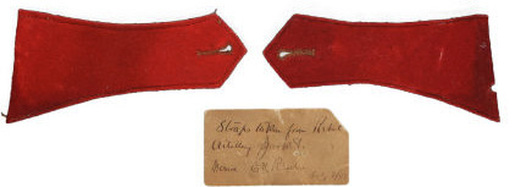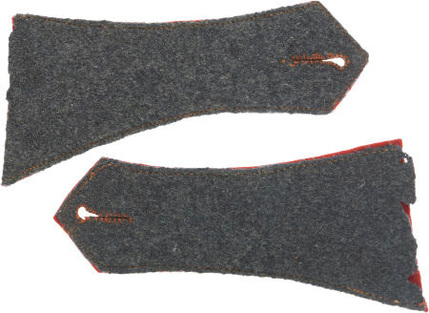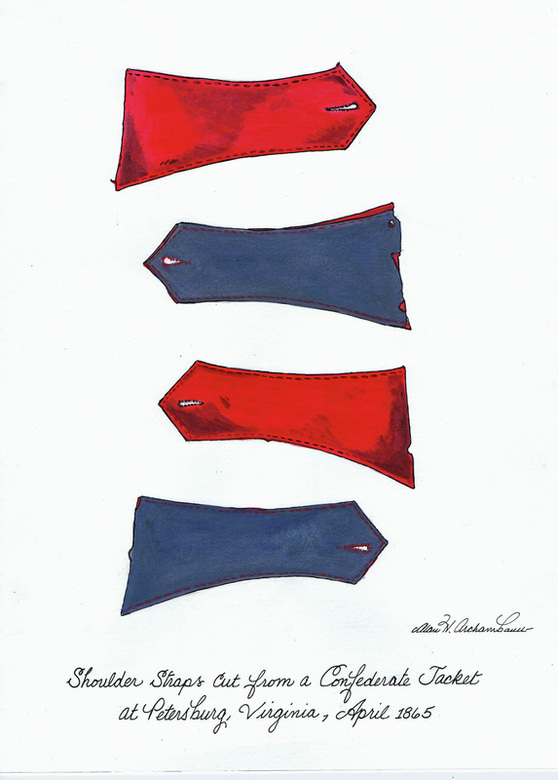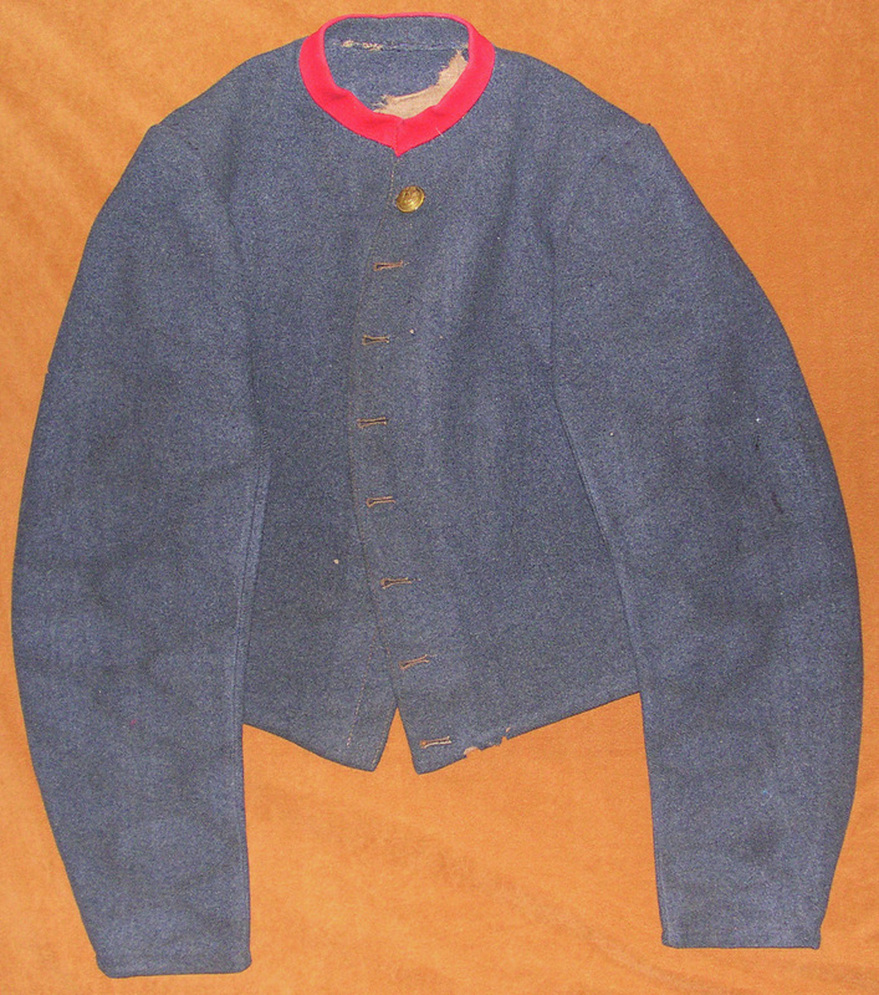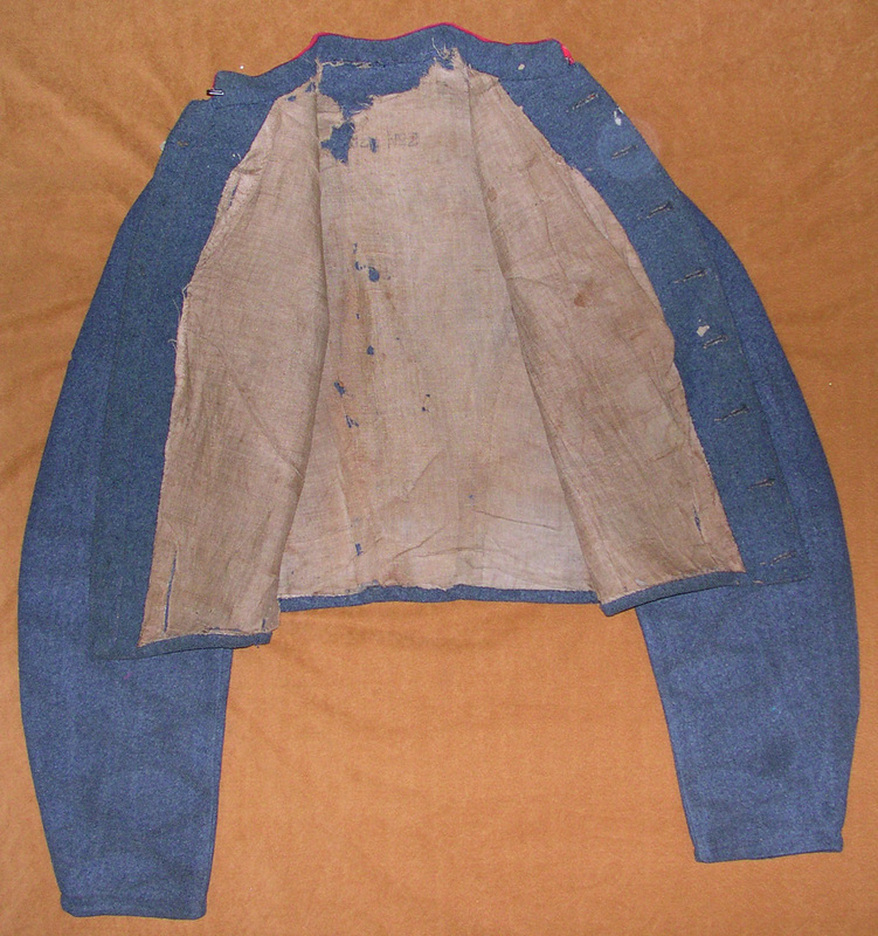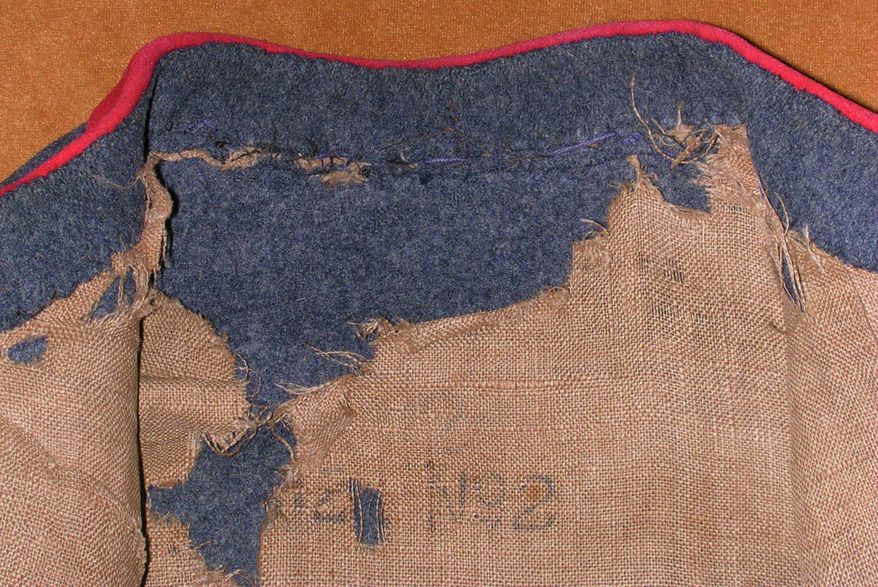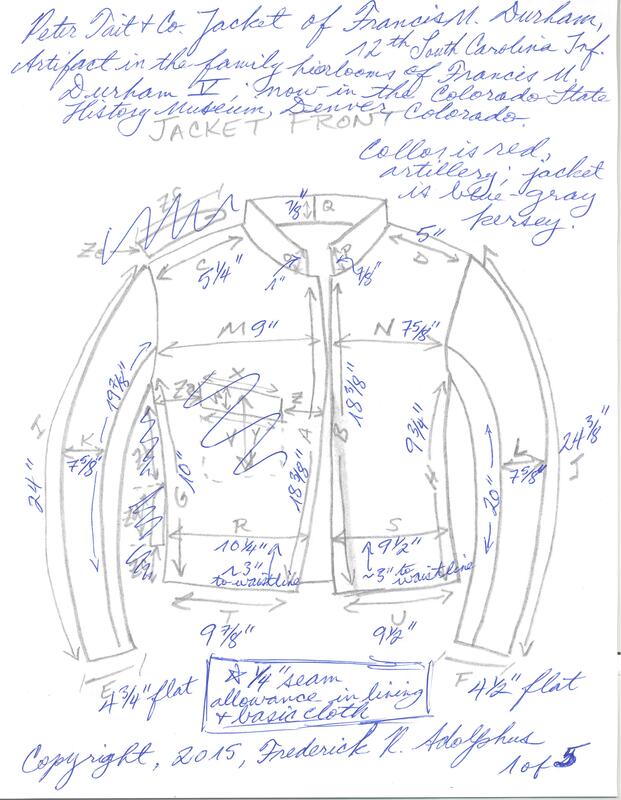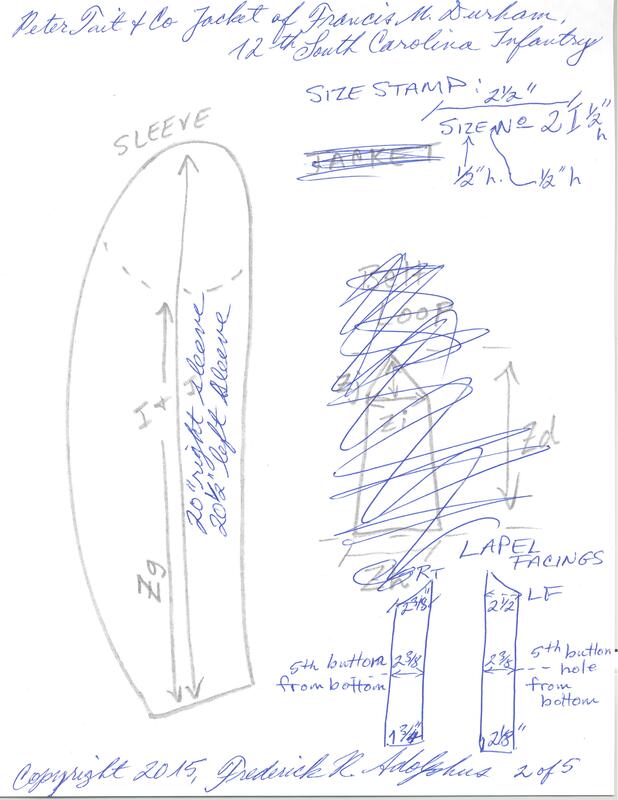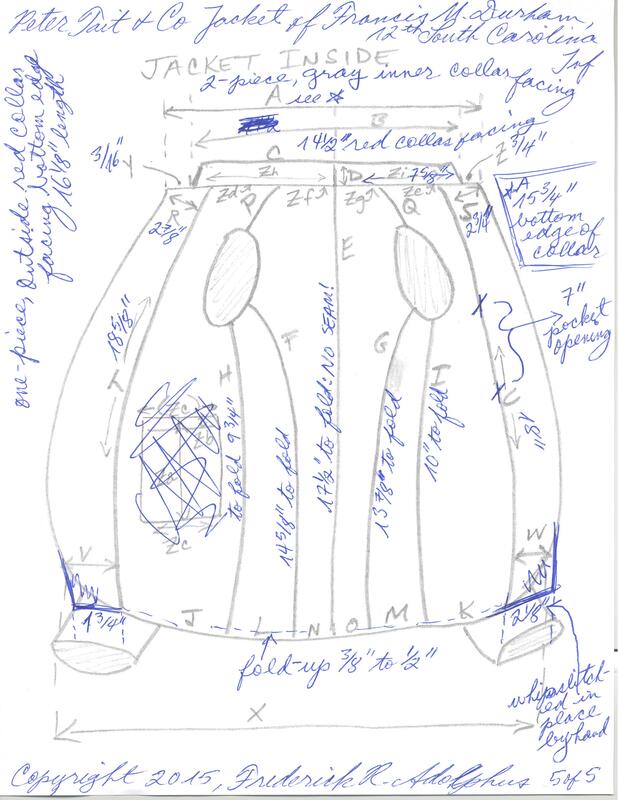Francis M. Durham "Peter Tait" Imported Jacket, and More...
By Fred Adolphus, 5 August 2011
By Fred Adolphus, 5 August 2011
Since publication of Imported Confederate Uniforms of Peter Tait & Co., Limerick, Ireland in December 2010, I have located another Tait artifact set, and found out the story behind another jacket for which little was known. One is a set of red artillery shoulder straps, and the other is the jacket attributed to collector Darby of Virginia.
The shoulder straps appeared in a lot advertised by Heritage Auctions in the summer of 2010. According to their provenance, Colonel Elisha Hunt Rhodes, Commander of the 2nd Rhode Island Volunteers, scavenged them as a souvenir. Rhodes gained fame both during and after the war, having risen through the ranks to become a regimental commander. He wrote two wartime reminiscences, and many of his wartime mementos are in the Rhode Island Historical Society collection. Some of Rhodes’ artifacts remain in private hands, most likely those of his descendants. Perhaps a descendent put the shoulder straps up for auction. In any case, the set did not bring the required reserve, and the owner withdrew the shoulder straps from further auctions.
Rhodes cut the shoulder straps from the jacket of a fallen Confederate artilleryman on April 2, 1865 at Fort Mahone, following the Battle of Petersburg. They are the variety and red shade of those belonging to the “full-trim” variant of Tait jacket. No buttons were included with the shoulder straps, if indeed Rhodes scavenged any buttons. In any case, the straps document the use of yet another full-trim Tait artillery jacket used by the Army of Northern Virginia.
The shoulder straps appeared in a lot advertised by Heritage Auctions in the summer of 2010. According to their provenance, Colonel Elisha Hunt Rhodes, Commander of the 2nd Rhode Island Volunteers, scavenged them as a souvenir. Rhodes gained fame both during and after the war, having risen through the ranks to become a regimental commander. He wrote two wartime reminiscences, and many of his wartime mementos are in the Rhode Island Historical Society collection. Some of Rhodes’ artifacts remain in private hands, most likely those of his descendants. Perhaps a descendent put the shoulder straps up for auction. In any case, the set did not bring the required reserve, and the owner withdrew the shoulder straps from further auctions.
Rhodes cut the shoulder straps from the jacket of a fallen Confederate artilleryman on April 2, 1865 at Fort Mahone, following the Battle of Petersburg. They are the variety and red shade of those belonging to the “full-trim” variant of Tait jacket. No buttons were included with the shoulder straps, if indeed Rhodes scavenged any buttons. In any case, the straps document the use of yet another full-trim Tait artillery jacket used by the Army of Northern Virginia.
FIG 1: Colonel Rhodes’ “souvenir” Confederate, red shoulder straps are from a Tait, full-trim variant artillery jacket. Images courtesy of Heritage Auctions.
FIG 2: The undersides of Rhodes’ shoulder straps are blue-gray kersey. Images courtesy of Heritage Auctions.
FIG 3: Military artist Alan Archambault has rendered a clearer image of the Rhodes shoulder straps than the low resolution photos allow. Courtesy of Alan Archambault.
The Tait jacket, tentatively attributed to a 1960s collector in Virginia named Darby, has been fully identified. Darby never owned the jacket. Instead, it is part of the Durham family collection, and presently resides in the Colorado State Museum collection. The jacket was originally owned by South Carolina Private Francis Marion Durham. According to the service records, Durham served in Company C, 12th South Carolina Infantry (part of the Army of Northern Virginia), and ended the ended the war a prisoner of the Yankees. If this was the case, he may have acquired the jacket second-hand while in prison, or on his way home to South Carolina. According to family legend, as conveyed by the jacket's present owner, Francis M. Durham V, his ancestor served with Pelham's Horse Artillery, and had several horses shot out from under him during the numerous battles in which he took part. Furthermore, he recieved several battlefield promotions, survived the Battle of the Crater, and returned home on horseback. On his way home, his horse threw a shoe in Virginia, and Durham bartered his jacket buttons, from the Tait jacket, for the services of a blacksmith to re-shoe his horse.
The Durham Tait jacket has a red collar, but it appears that the height has been trimmed down. Perhaps Confederate soldier Durham had the collar re-tailored. The jacket is also missing its original Tait, factory-applied buttons, having only a single, Virginia state button at the collar. The linen lining has a single pocket opening in the left lapel and the back piece is stamped “SIZE No2”. I included images of this jacket on page 37 of my book, and I erroneously reported that it was without provenance. Due to photos furnished by the State of Colorado, and the details of provenance offered by descendent Frank Durham V, we now know the truth about this wonderful artifact. Until I see it in person for the first time, I definitely have something to look forward to!
The Durham Tait jacket has a red collar, but it appears that the height has been trimmed down. Perhaps Confederate soldier Durham had the collar re-tailored. The jacket is also missing its original Tait, factory-applied buttons, having only a single, Virginia state button at the collar. The linen lining has a single pocket opening in the left lapel and the back piece is stamped “SIZE No2”. I included images of this jacket on page 37 of my book, and I erroneously reported that it was without provenance. Due to photos furnished by the State of Colorado, and the details of provenance offered by descendent Frank Durham V, we now know the truth about this wonderful artifact. Until I see it in person for the first time, I definitely have something to look forward to!
FIG 4: The front of the Durham jacket exhibits eight, keyhole buttons and the blue-gray kersey typical of all Tait jackets. Artifact courtesy of History Colorado, Francis Marion Durham Collection, Photo. #2005.52.3.v1.
FIG 5: Another front view depicts the machine stitching along the button lapel. The scarlet collar facing has been added to what a plain variant Tait jacket. The Virginia button may indicate that a Virginia soldier originally wore the jacket. Artifact courtesy of History Colorado, Francis Marion Durham Collection, Photo. #2005.52.3.v2.
FIG 6: The inside lining is unbleached linen, has a single pocket in the left lapel, and bears a size stamp. Artifact courtesy of History Colorado, Francis Marion Durham Collection, Photo. #2005.52.3.v3.
FIG 7: The back of the Durham jacket has the single-piece back placket. Artifact courtesy of History Colorado, Francis Marion Durham Collection, Photo. #2005.52.3.v4.
FIG 8: The size stamp is partially obliterated, but enough remains to decipher “SIZE No2”. Artifact courtesy of History Colorado, Francis Marion Durham Collection, Photo. #2005.52.3.v5.
This series of five sketches provides researchers with the dimensions of Durham's jacket.
Acknowledgements: The author wishes to thank Garrett Glover for having brought the Elisha Hunt Rhodes shoulder straps to his attention, as well as, Mr. James Peterson, Curator of Collections, Colorado State History Museum, and the Francis M. Durham V for his patient emails filling me in on the family history. Also, all images herein are copyrighted by Adolphus Confederate Uniforms and may not be used or re-published in any form without the express consent of the Frederick R. Adolphus.
This website and its content is copyright of Adolphus Confederate Uniforms.
© Adolphus Confederate Uniforms 2010-2021. All rights reserved.
Email us | Copyright | Disclaimer | Terms of Use | PDF Download Help
© Adolphus Confederate Uniforms 2010-2021. All rights reserved.
Email us | Copyright | Disclaimer | Terms of Use | PDF Download Help
